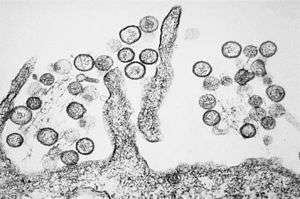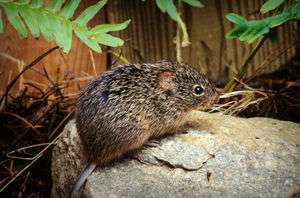Hantavirus pulmonary syndrome
Hantavirus pulmonary syndrome (HPS) is one of two potentially fatal syndromes of zoonotic origin caused by species of hantavirus.[1] These include Black Creek Canal virus (BCCV), New York orthohantavirus (NYV), Monongahela virus (MGLV), Sin Nombre orthohantavirus (SNV), and certain other members of Hantavirus genera that are native to the United States and Canada.[2] Specific rodents are the principal hosts of the hantaviruses including the hispid cotton rat (Sigmodon hispidus) in southern Florida, which is the principal host of Black Creek Canal virus.,[3][4] The deer mouse (Peromyscus maniculatus) in Canada and the Western United States is the principal host of Sin Nombre virus.[5][6] The white-footed mouse (Peromyscus leucopus) in the eastern United States is the principal host of New York virus.[7] In South America, the Oligoryzomys longicaudatus and other species of the genus Oligoryzomys have been documented as the reservoir for Andes virus.[8][9][10]
| Hantavirus pulmonary syndrome | |
|---|---|
 | |
| Transmission electron micrograph of Sin Nombre orthohantavirus | |
| Specialty | Pulmonology |
Signs and symptoms
Prodromal symptoms are flu-like ones, such as fever, cough, myalgia, headache, lethargy, and shortness of breath, which rapidly deteriorates into acute respiratory failure. It is characterized by the sudden onset of shortness of breath with rapidly evolving pulmonary edema; it is often fatal despite mechanical ventilation and intervention with potent diuretics. It has a fatality rate of 36%.
Transmission

Transmission by aerosolized rodent excreta still remains the only known way the virus is transmitted to humans. In general, droplet and/or fomite transfer has not been shown in the hantaviruses in either the pulmonary or hemorrhagic forms.[11][12]
Diagnosis
According to Kevin Litman-Navarro, "HPS can be easy to overlook because its early symptoms are very similar to the flu. Infected patients suffer from fatigue, fever, and muscle aches often accompanied by headaches, dizziness and gastrointestinal problems in the weeks following exposure. About a week after the initial symptoms subsided, the second phase of the disease sets in, and patients experience severe coughing and shortness of breath as the lungs fill with fluid. In the later stages of HPS, the lungs are severely damaged, resulting in a fatality rate of about 38 percent." [13]
Prevention
Rodent control in and around the home or dwellings remains the primary prevention strategy, as well as eliminating contact with rodents in the workplace and at campsites. Closed storage sheds and cabins are often ideal sites for rodent infestations. Airing out of such spaces prior to use is recommended. People are advised to avoid direct contact with rodent droppings and wear a mask while cleaning such areas to avoid inhalation of aerosolized rodent secretions.[14]
Treatment
There is no cure or vaccine for HPS. Treatment involves supportive therapy, including mechanical ventilation with supplemental oxygen during the critical respiratory-failure stage of the illness. Early recognition of HPS and admission to an intensive care setting offers the best prognosis.
Epidemiology
Hantavirus pulmonary syndrome was first recognized during the 1993 outbreak in the Four Corners region of the southwestern United States. It was identified by Dr. Bruce Tempest. It was originally called Four Corners disease, but the name was changed to Sin Nombre virus after complaints by Native Americans that the name "Four Corners" stigmatized the region.[15] It has since been identified throughout the United States.
See also
- 1993 Four Corners hantavirus outbreak
- Sweating sickness
- Calabazo virus
- Rockport virus
References
- Koster FT. Levy H. "Hantavirus cardiopulmonary syndrome: a new twist to an established pathogen", In: Fong IW, editor; Alibek K, editor. New and Evolving Infections of the 21st Century, New York: Springer-Verlag New York, Inc.; 2006. pp. 151–170.
- Nichol ST. Beaty BJ. Elliott RM. Goldbach R, et al. Family Bunyaviridae. In: Fauquet CM, editor; Mayo MA, editor; Maniloff J, editor; Desselberger U, et al., editors. Virus Taxonomy: 8th Report of the International Committee on Taxonomy of Viruses. San Diego, CA: Elsevier Academic Press;
- Rollin PE. Ksiazek TG. Elliott LH. Ravkov EV, et al. "Isolation of Black Creek Canal virus, a new hantavirus from Sigmodon hispidus in Florida", J Med Virol. 1995;46:35–39. [PubMed]
- Glass GE. Livingstone W. Mills JN. Hlady WG, et al. "Black Creek Canal virus infection in Sigmodon hispidus in southern Florida", Am J Trop Med Hyg. 1998;59:699–703. PubMed
- Childs JE, Ksiazek TG, Spiropoulou CF, Krebs JW, Morzunov S, Maupin GO, Gage KL, Rollin PE, Sarisky J, Enscore RE (1994). "Serologic and genetic identification of Peromyscus maniculatus as the primary rodent reservoir for a new hantavirus in the southwestern United States". J. Infect. Dis. 169 (6): 1271–80. doi:10.1093/infdis/169.6.1271. PMID 8195603.
- Drebot MA. Gavrilovskaya I. Mackow ER. Chen Z, et al. "Genetic and serotypic characterization of Sin Nombre-like viruses in Canadian Peromyscus maniculatus mice", Virus Res. 2001;75:75–86. [PubMed]
- Hjelle B. Lee SW. Song W. Torrez-Martinez N, et al. "Molecular linkage of hantavirus pulmonary syndrome to the white-footed mouse, Peromyscus leucopus: genetic characterization of the M genome of New York virus", J Virol. 1995;69:8137–8141. [PMC free article] [PubMed]
- Wells RM, Sosa Estani S, Yadon ZE, Enria D, Padula P, Pini N, Mills JN, Peters CJ, Segura EL (April–June 1997). "An unusual hantavirus outbreak in southern Argentina: person-to-person transmission? Hantavirus Pulmonary Syndrome Study Group for Patagonia". Emerg Infect Dis. 3 (2): 171–4. doi:10.3201/eid0302.970210. PMC 2627608. PMID 9204298.
- Levis S, Morzunov SP, Rowe JE, Enria D, Pini N, Calderon G, Sabattini M, St Jeor SC (March 1998). "Genetic diversity and epidemiology of hantaviruses in Argentina". J Infect Dis. 177 (3): 529–38. doi:10.1086/514221. PMID 9498428.
- Cantoni G, Padula P, Calderón G, Mills J, Herrero E, Sandoval P, Martinez V, Pini N, Larrieu E (October 2001). "Seasonal variation in prevalence of antibody to hantaviruses in rodents from southern Argentina". Trop Med Int Health. 6 (10): 811–6. doi:10.1046/j.1365-3156.2001.00788.x. PMID 11679129.
- Peters, C.J. (2006). "Emerging Infections: Lessons from the Viral Hemorrhagic Fevers". Transactions of the American Clinical and Climatological Association. 117: 189–197. PMC 1500910. PMID 18528473.
- Crowley, J.; Crusberg, T. "Ebola and Marburg Virus Genomic Structure, Comparative and Molecular Biology". Dept. of Biology & Biotechnology, Worcester Polytechnic Institute. Archived from the original on 2013-10-15.
- Litman-Navarro, Kevin. "U.S. Woman Dies From Hantavirus, a Flu-Like Disease Spread by Rodents". Inverse.com.
- "CDC - Hantavirus Pulmonary Syndrome (HPS) - Hantavirus". Cdc.gov. 2013-02-06. Retrieved 2013-07-07.
- "Death at the Corners". Discover Magazine. 1993-12-01. Retrieved 2013-03-25.
External links
| Wikimedia Commons has media related to Hantaviruses. |
- Muerto Canyon by Jen Peel, 29 minutes, Sloan Science and Film
- "Hantaviruses, with emphasis on Four Corners Hantavirus" by Brian Hjelle, M.D., 2001, Department of Pathology, School of Medicine, University of New Mexico
- Hantavirus Technical Information Index page, US Center for Disease Control
- Viralzone: Hantavirus
- Virus Pathogen Database and Analysis Resource (ViPR): Bunyaviridae
- Hantavirus - Occurrences and deaths in North and South America, 1993-2004, PAHO